Rice is one of the staple foods largely grown in China. It is also the main starch ingredient when it comes to the majority of Chinese cuisine. People in China consume rice in many different forms. It can be consumed as whole grain or turned into flour and used to make rice noodles and dumplings among other traditional dishes.
Rice flour is, however, not to be confused with Glutinous rice flour. Also called Mifen in Chinese, rice flour is fine flour made from gluten-free rice. That is different from glutinous rice flour made from sweet or glutinous rice. Rice flour has a neutral flavor and its color mainly ranges from white to brown depending on whether white or brown rice was used. It is also hypoallergenic hence used in gluten-free baking and is said to be easily digestible.
To further understand what rice flour is in China, we will look at the different methods the Chinese use to prepare rice flour. We will also cover the number of things that can be done with the rice flour. As a bonus, we will also give you a simple recipe you can make using Chinese rice flour.
what are rice noodles?
Rice noodles, also known as rice vermicelli, are a type of noodle made from rice flour or rice starch. They are a staple ingredient in many Asian cuisines, particularly in Southeast Asia and East Asia. Rice noodles have a long, thin, and translucent appearance and a slightly chewy texture when cooked.
To make rice noodles, rice flour or rice starch is mixed with water to form a dough, which is then steamed, boiled, or sometimes sun-dried. The dough is typically extruded through small holes or pressed into sheets, and then cut into various shapes and sizes, such as thin strands or wide ribbons. The noodles are often sold dried and require soaking or boiling before use.
what are rice noodles called in chinese?
In Chinese, rice noodles are called “米粉” (mǐ fěn) or “河粉” (hé fěn). “米” (mǐ) means rice, and “粉” (fěn) refers to noodles or flour-based products. The term “河粉” (hé fěn) specifically refers to wide rice noodles commonly used in dishes like Beef Ho Fun (牛河) or Char Kway Teow (炒粿条).
what are rice noodles made of?
Rice noodles are made primarily from rice flour and water. The process involves grinding rice into a fine powder to create rice flour, which is then mixed with water to form a dough. The dough is typically rolled out and shaped into thin sheets, which are then cut into various noodle shapes, such as flat or thin strands. The noodles are often dried or cooked fresh depending on the desired texture and usage. Rice noodles can vary in thickness, width, and length, and they are a popular staple in many Asian cuisines, including Chinese, Thai, Vietnamese, and Malaysian.
how many kinds of rice noodles?
There are various types of rice noodles, including rolled rice noodles, square rice noodles, wavy rice noodles, silver thread rice noodles, wet rice noodles, dry rice noodles, and more. The production process for these noodles is similar, generally involving the following steps: rice washing, soaking, grinding, steaming the rice paste, pressing or extruding the noodles, re-steaming, cooling, drying, packaging, and the final product.
Rice noodles are popular in southern China, where rice production is abundant. People in the southern regions are accustomed to eating rice as their staple food and find dry foods less palatable, so rice noodles are commonly served in soups. The preparation and seasoning of rice noodles vary across different regions in the south. For example, rice noodles from Guizhou Province are often spicy, with the soup being almost red in color. Guilin rice noodles and rice noodles produced in Xin Zhu, Taiwan, are also well-known. In Jiangxi Province, rice noodles are a beloved food and are almost always present at banquets or gatherings.
Rice noodles come in various types and can be classified into different categories based on their shape, texture, and production methods. Some common types of rice noodles include:
Ho Fun: Ho Fun is a wide, flat rice noodle commonly used in Cantonese cuisine. It has a white color, tender texture, and is often used in stir-fries and soups.
Rice Vermicelli: Rice vermicelli is a thin, thread-like rice noodle. It has a soft and delicate texture and is commonly used in dishes like stir-fries, salads, and spring rolls.
Rice Stick Noodles: Rice stick noodles are long, thin noodles that are often used in dishes like Pad Thai. They have a chewy texture and can be stir-fried or used in soups.
Guilin Rice Noodles: Guilin Rice Noodles are a specialty from Guilin, China. They are thin and translucent rice noodles that are typically served in a flavorful broth with various toppings like beef or pork slices.
Rice Noodle Rolls: Rice noodle rolls, also known as Cheung Fun, are made by steaming a thin rice batter and rolling it into a cylindrical shape. They are often served with soy sauce or a sweet sauce and can be filled with ingredients like shrimp or barbecued pork.
Rice Thread Noodles: Rice thread noodles, also known as rice vermicelli sticks, are thin and round noodles that can be used in soups, stir-fries, or salads.
These are just a few examples of rice noodle varieties, and there are many more based on regional cuisines and preferences. Rice noodles are a versatile ingredient and can be used in a wide range of dishes, both savory and sweet.
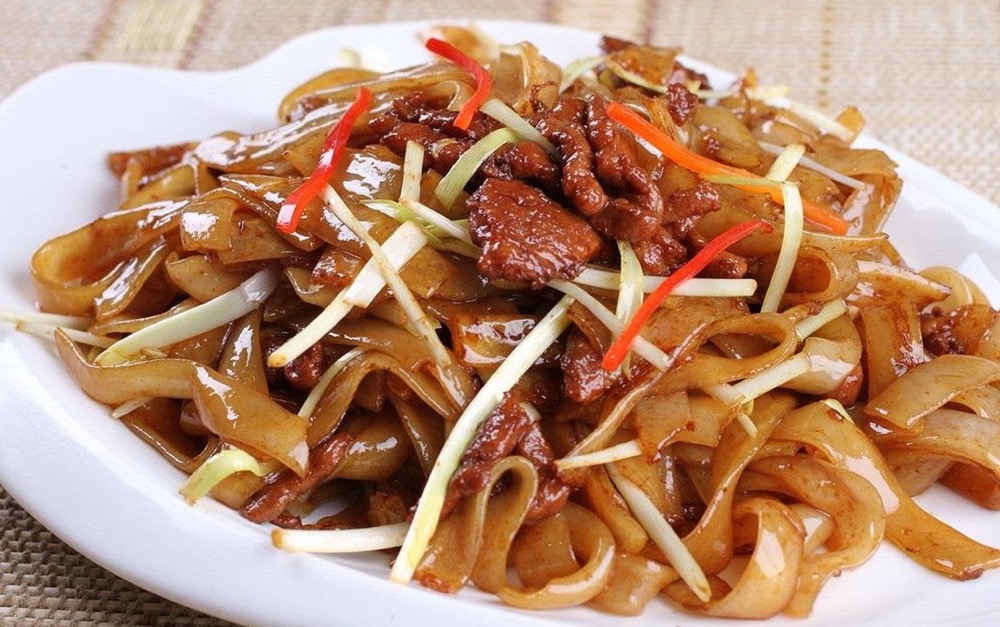
famous rice noodle
Changde Rice Noodles
Changde Rice Noodles are a popular Han Chinese snack originating from the Changde region in Hunan province. These rice noodles have a long history and are well-known in the Three Xiang region.
They are highly regarded due to their fine craftsmanship and the “three floating and three cooked” cooking method.
After undergoing more than ten hours of preparation, the rice noodles are made into clean, round, thin, and elastic strands. They are smooth and delicious to eat, served with various toppings such as shredded meat, sliced meat, braised sauce, soy sauce, braised dishes, spicy oil, mushroom oil, and more.
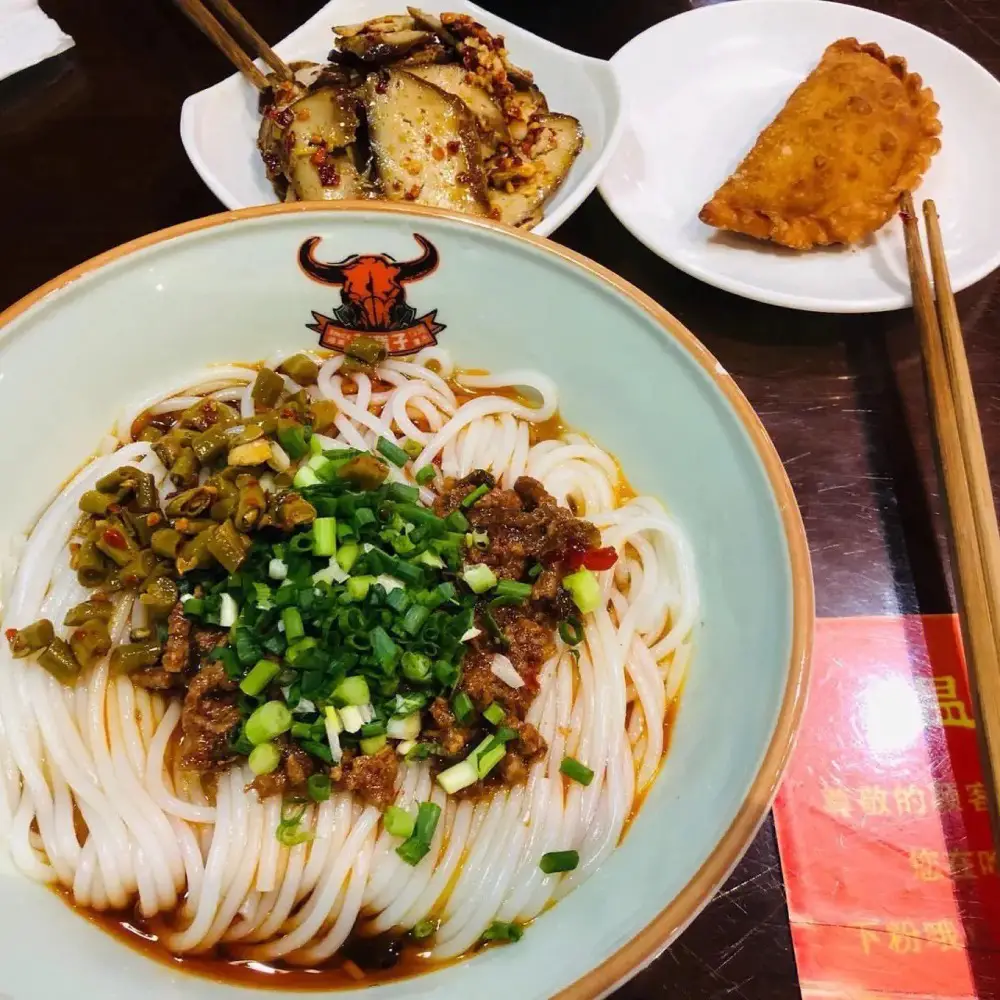
Guilin Rice Noodles
Guilin Rice Noodles are renowned beyond the realm of rice noodles themselves.
If you have visited the local area, you would find rice noodle shops everywhere, and they are extremely affordable, sold by weight.
They have a soft, smooth, and tender texture, with a clean and delicate appearance, highlighting their exceptional qualities.
The highlight lies in the preparation of the soup, as different shops have their own secret recipes, resulting in hundreds of flavors of Guilin Rice Noodles.
Due to climatic conditions and geographical locations, rice noodle flavors vary greatly in different regions. Besides the famous Guilin Rice Noodles and Nanning Laoyoufen, there are also Qinzhou Pig Trotter Rice Noodles, Yulin Niu Ba Rice Noodles, Binyang Sour Rice Noodles, Nanning Baozhen Rice Noodles, Shengzha Rice Noodles, Zhuzha Rice Noodles, Char Siu Rice Noodles, Vegetarian Rice Noodles, and even the nationally renowned Luosifen with its unique aroma. There are also variations like the Vietnamese-style Ho Fun and Rolled Rice Noodles.
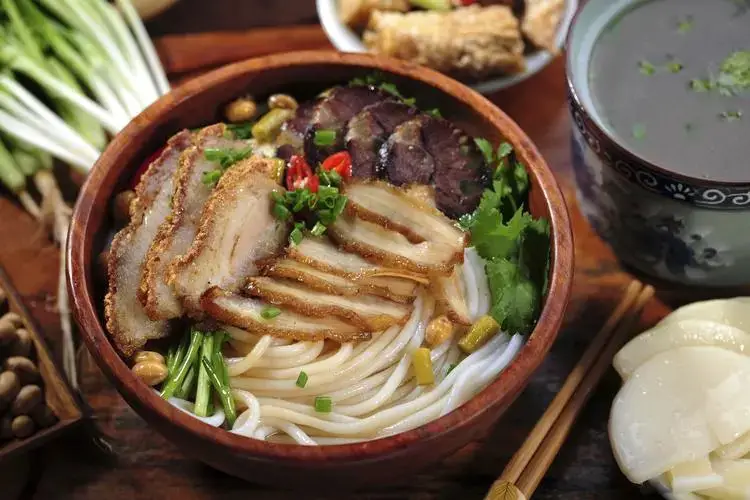
Yunnan Crossing the Bridge Rice Noodles
Crossing the Bridge Rice Noodles are a unique snack from the southern Yunnan region, belonging to Yunnan cuisine.
The broth is made using a combination of large bones, old mother chicken, and Yunnan Xuanwei ham, simmered for a long time.
Crossing the Bridge Rice Noodles consist of four components: broth, condiments, main ingredients, and side ingredients.
With a wide variety of ingredients, they offer a distinct layering of flavors.
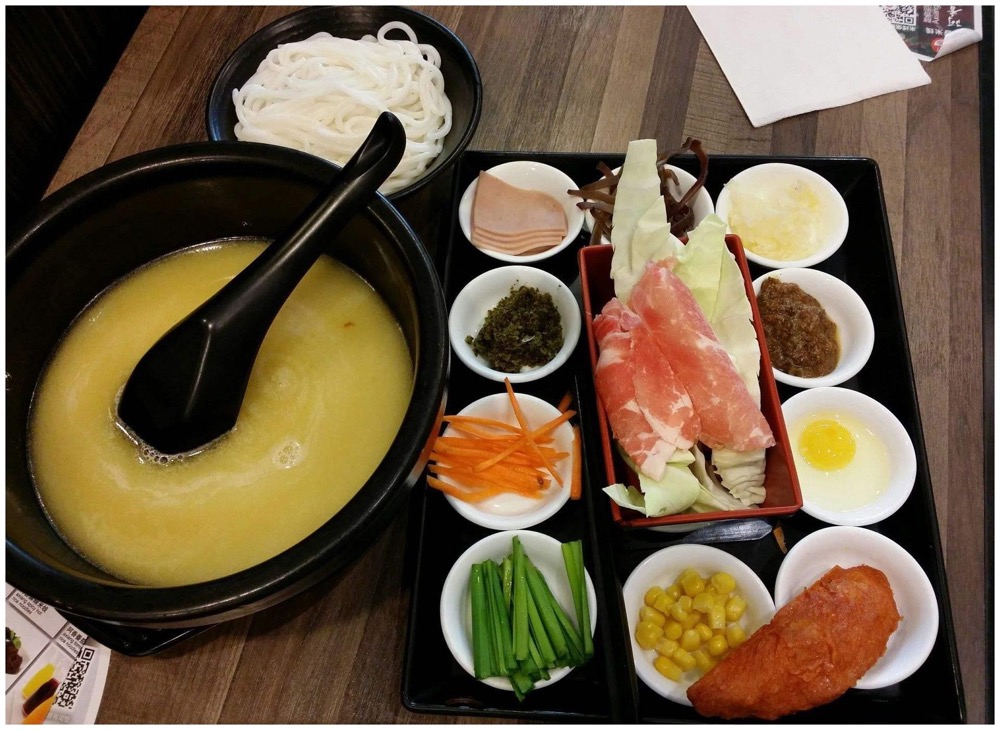
Sichuan Mianyang Rice Noodles
Mianyang Rice Noodles share similarities with Yunnan Rice Noodles as both use rice as the main ingredient and have a noodle-like shape.
The difference lies in the preparation method of Mianyang Rice Noodles. They are “cooked” by submerging the rice noodles in boiling water using a bamboo ladle, then scooped into a bowl and topped with broth before consumption.
In terms of taste, they are fresh, fragrant, smooth, and tender.
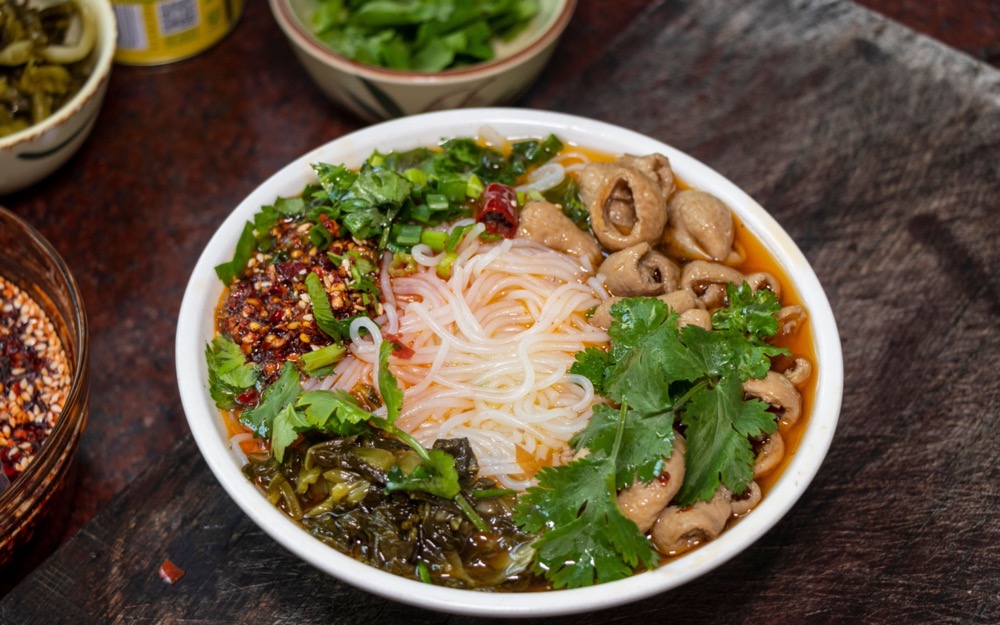
Chongqing Hot and Sour Rice Noodles
“Chongqing Hot and Sour Rice Noodles” is a natural and green food. It has been highly popular among the people of Chongqing due to its unique and appetizing hot and sour flavor. It is characterized by its “numbing, spicy, fresh, fragrant, sour, and oily yet not greasy” taste.
It is known as the “number one rice noodle in the world” for its exquisite flavor.
The taste is sour, fragrant, rich, slightly sweet, with a subtle vinegar aroma that is not overpowering. The aroma and flavor of Chongqing Hot and Sour Rice Noodles are truly exceptional.
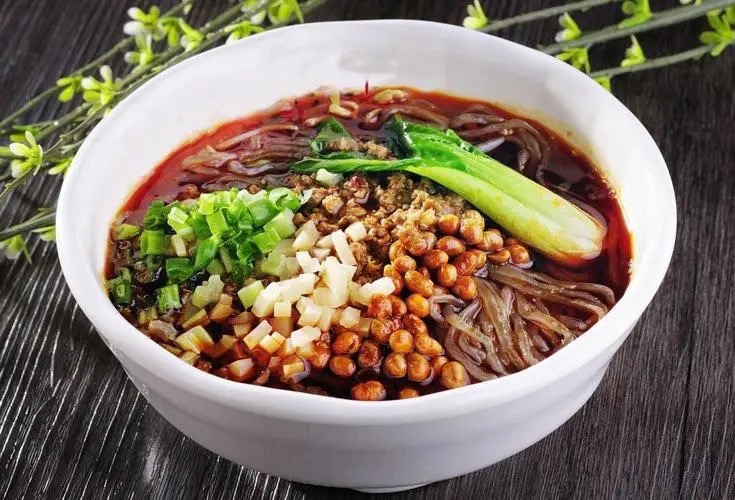
Jiangxi Yanshan Scalded Rice Noodles
In Yanshan, people don’t eat dry rice noodles; instead, they make and eat them fresh.
The coarse rice noodles are white and tender, sliding smoothly in the mouth. The fine rice noodles are slippery and chewy, not easily broken when bitten.
When you dip them in boiling water, the noodles dance into the bowl. Then, add some scallions, a spoonful of lard, a sprinkle of salt and MSG, and you have a perfect dish.
Yanshan Scalded Rice Noodles are famous in the Shangrao region and throughout Jiangxi province.

Liuzhou Snail Rice Noodles
Liuzhou Snail Rice Noodles mainly consist of round and flat rice noodles, accompanied by snail meat as the main ingredient. The snail meat can be sourced from field snails or small snails found in rivers and streams. The snail meat is minced together with some pork, mixed with spices, soy sauce, monosodium glutamate (MSG), a small amount of broth, sugar, vinegar, and cornstarch.
Before eating, the rice noodles are briefly blanched in boiling water, then scooped out and mixed with the aforementioned ingredients, along with a sprinkle of cilantro.
This dish has a fragrant and savory flavor with a hint of snail essence. Those who enjoy spiciness can add some chili sauce to enhance the refreshing and invigorating experience.
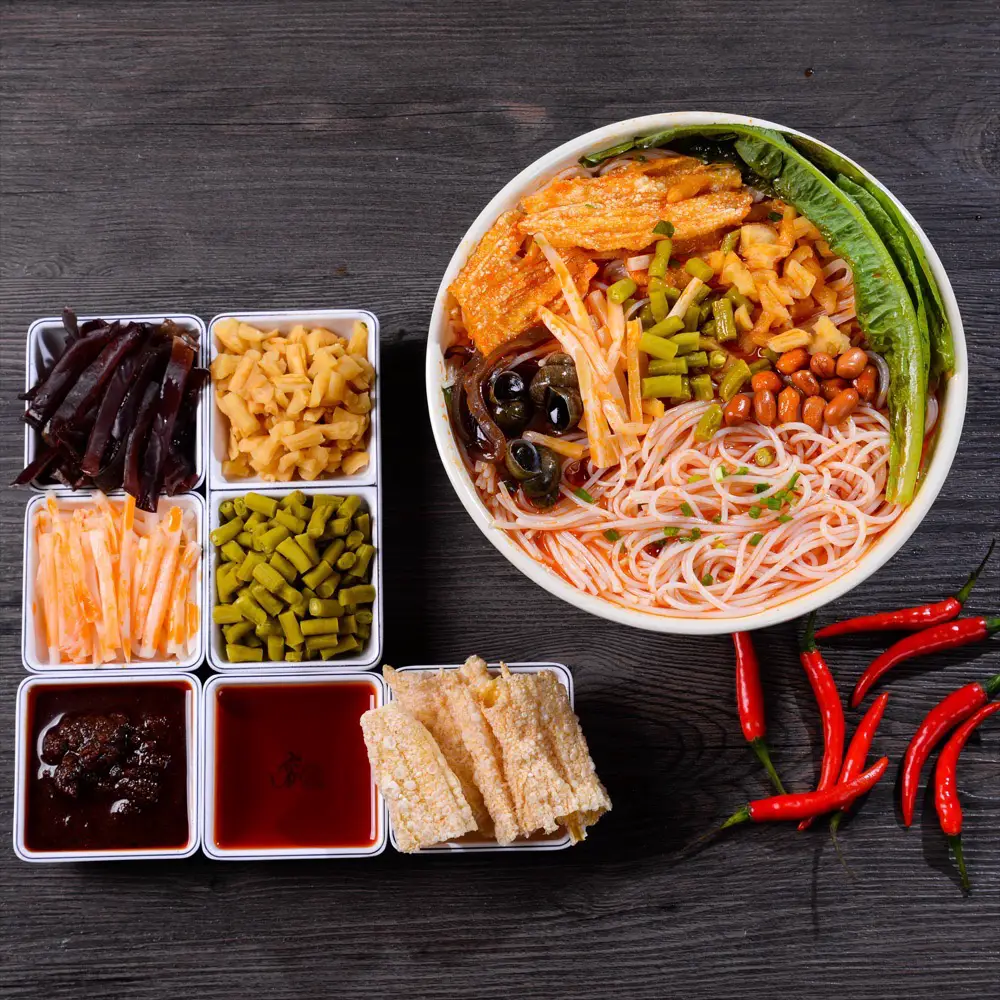
Fujian Antaiqiao Rice Noodles
Antaiqiao Rice Noodles from Putian City, Fujian Province, are made from high-quality Huangjiamai rice. The production process involves nine steps, which used to be done manually but now incorporates semi-mechanized techniques.
The rice noodles are characterized by their slender and even strands, with a clean and white appearance. They are easy to cook, whether in soups or dry stir-fries, and have a distinctive flavor.
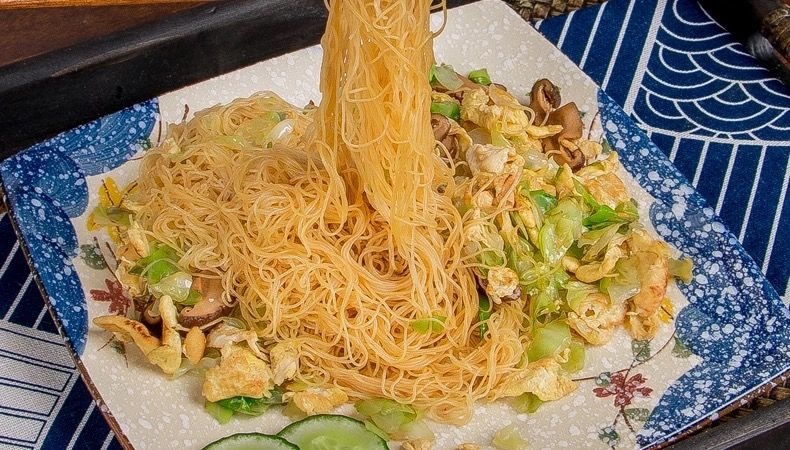
Hakka Rice Noodles
Hakka Rice Noodles are a traditional Han Chinese delicacy, also known as “Fen Gan” in Changting County, Fujian Province. They belong to the Min cuisine.
Different from rice vermicelli and Guilin Rice Noodles, Hakka Rice Noodles have white and clean strands. They are easy to cook and remain firm even when boiled for a long time. They have a fragrant, smooth, and refreshing taste, with the original aroma of rice.
They can be stir-fried or cooked and are particularly suitable for individuals who prefer relatively mild flavors.
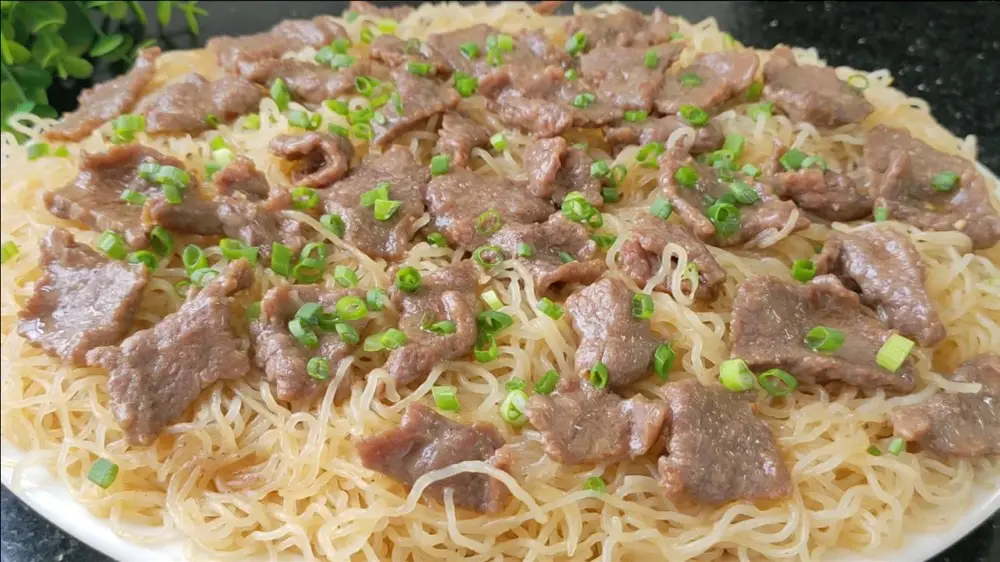
Hunan Shaoyang Rice Noodles
The distinctive feature of Shaoyang Rice Noodles lies in the unique texture of the rice noodles themselves. They are chewy and have a substantial bite.
Another characteristic is that they are not served with a plain broth but instead use the original flavorful soup, resulting in a generous amount of toppings. This creates a sense of sophistication similar to Japanese cuisine.
The rice noodles are chewy with resilience, coarse in texture yet smooth, and provide a satisfying bite. They are undeniably bold and full of character.
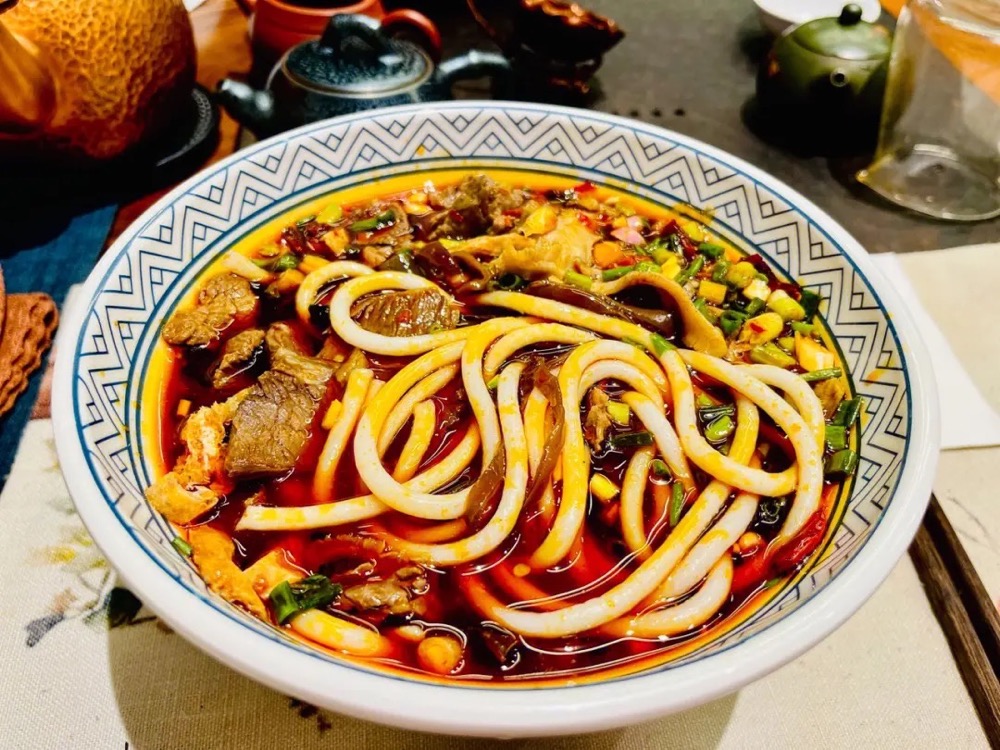
Heyuan Rice Noodles
Heyuan Rice Noodles are a specialty of Dongyuan County, Heyuan City, Guangdong Province. They go through ten processes to create a type of rice product known as “Shou Pai,” which can be steamed, boiled, stir-fried, or deep-fried. They can be paired with different broths or condiments to create various regional flavors, making them versatile and beloved by the locals.
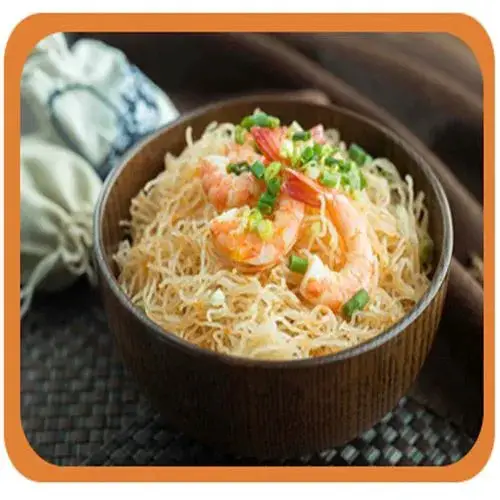
Jiangxi Rice Noodles
The most famous Jiangxi Rice Noodle dish is “Ban Fen” in Nanchang, which is often accompanied by a bowl of clay pot soup. Unlike rice noodles from other regions, Nanchang rice noodles require high elasticity. Uncooked rice noodles are solid and transparent, and after cooking, they turn white and maintain their shape even after soaking for a long time or stir-frying without breaking apart. They are chewy yet tender. A few drops of soy sauce and sesame oil, along with peanuts, pickled vegetables, radish, and minced meat or beef, are added as toppings, creating a seemingly simple combination that offers a complex and delightful flavor.
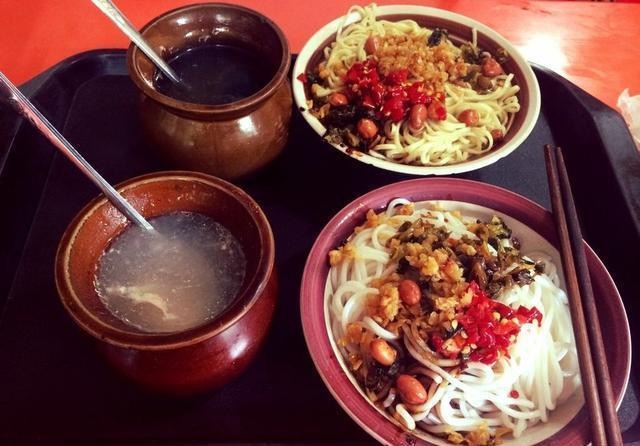
Hunan Changsha Rice Noodles
Hunan Changsha Rice Noodles, Changde Rice Noodles, Shaoyang Rice Noodles, and others have similar appearances, with both round and flat rice noodles. However, there are variations in taste, particularly in the toppings. For example, Changde Rice Noodles are known for their beef toppings, while Changsha Rice Noodles incorporate the delicious aspects of neighboring regions’ rice noodle dishes, resulting in a more diverse combination. Additionally, there are sour and spicy rice noodles with the flavors of the Miao and Yao ethnic groups in several counties of Xiangxi, which always surprise with unexpected combinations and tastes. In summary, when visiting Hunan, make sure to find a place to enjoy rice noodles as a satisfying meal.
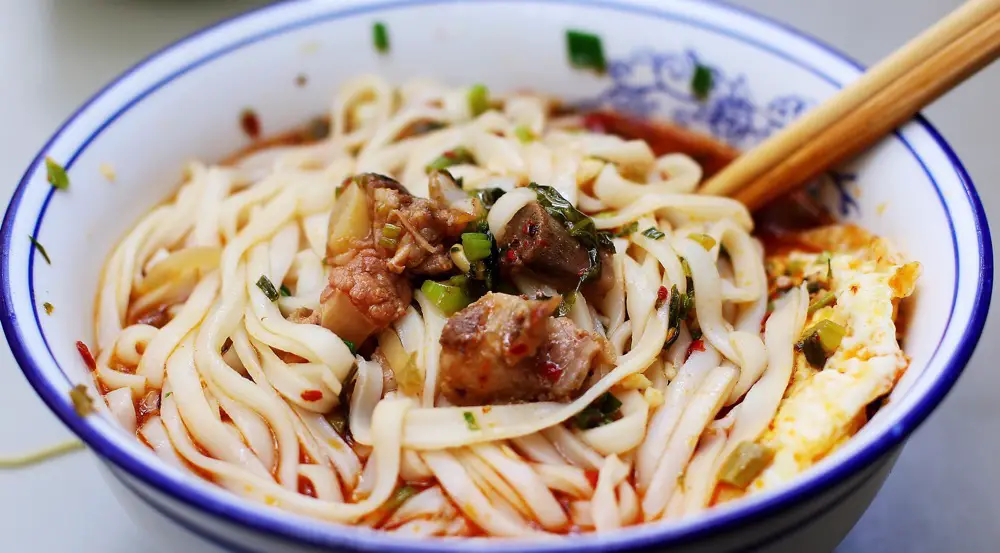
what are rice noodles like?
Rice noodles are a type of noodle made from rice flour or rice starch. They have a long history and are widely consumed in various cuisines, particularly in Asian countries such as China, Thailand, Vietnam, and Malaysia. Here are some characteristics of rice noodles:
Texture: Rice noodles have a soft and smooth texture. They are delicate and have a pleasant chewiness when cooked properly. The texture can vary depending on the thickness and width of the noodles, ranging from thin and delicate to wider and more substantial strands.
Appearance: Rice noodles come in different shapes and sizes, including thin vermicelli, flat sheets, or broader strands. The shape and thickness of the noodles can vary based on the specific dish they are used in.
Translucency: Rice noodles are often translucent when cooked, especially the thinner varieties. This transparency allows them to absorb flavors from sauces and broths while maintaining their own distinct taste.
Quick cooking: Rice noodles cook relatively quickly compared to other types of noodles. They can be boiled, soaked in hot water, or stir-fried, depending on the dish being prepared. Overcooking rice noodles can cause them to become mushy, so it’s important to follow the recommended cooking time.
Neutral flavor: Rice noodles have a mild and neutral flavor, which makes them versatile for use in various dishes. They act as a base to absorb the flavors of accompanying sauces, broths, or stir-fry seasonings.
Gluten-free: Rice noodles are naturally gluten-free, which makes them suitable for individuals with gluten sensitivities or those following a gluten-free diet.
Rice noodles are commonly used in dishes such as stir-fries, soups, salads, and spring rolls. They provide a light and satisfying element to these dishes, complementing the flavors of other ingredients. The specific characteristics of rice noodles can vary across different regional cuisines, giving rise to diverse and unique preparations and combinations.
what are rice noodles good with?
Sour Green Beans (Sour Green Beans with Minced Meat)
Pickled Vegetables (Sour Cabbage)
Coriander/Cilantro
Preserved Vegetable (Zha Cai)
Fried Egg (Pocket Egg)
Chopped Chili
Pickled Radish (Sour Radish)
Diced Celery
Leafy Greens (Spinach)
Shiitake Mushroom
Shredded Potato
Black Bean Paste (Fermented Black Bean Sauce)
Fried Soybeans
Shredded Kelp (Kelp Strips)
Peanuts
are rice noodles the same as rice?
Rice noodles are made from rice flour, but they are not the same as whole rice grains. While both rice and rice noodles are derived from rice, they undergo different processing methods and have distinct characteristics.
Rice is a staple grain and is typically cooked by boiling or steaming the whole grains. It is commonly eaten as a side dish or used as a base for various dishes.
On the other hand, rice noodles are made by grinding rice into flour and then shaping the flour into noodle-like strands. The rice flour is mixed with water or other ingredients to form a dough, which is then cut into noodles of different thicknesses and shapes. Rice noodles are often used in Asian cuisine, such as in dishes like pho, pad Thai, or stir-fried noodles.
So, while rice and rice noodles share a common origin, they have different textures, cooking methods, and culinary uses.
How To Make Chinese Rice Flour?
There are two main ways to make rice flour. You can either grind it or mill it. Grinding it results in dry rice flour, with milling, however, there can either be dry milling or wet milling. Dry milling uses dry rice grains while wet milling uses presoaked rice grains. The following are some of the steps you can take to make rice flour using either of the two main methods.
Grinding using a blender
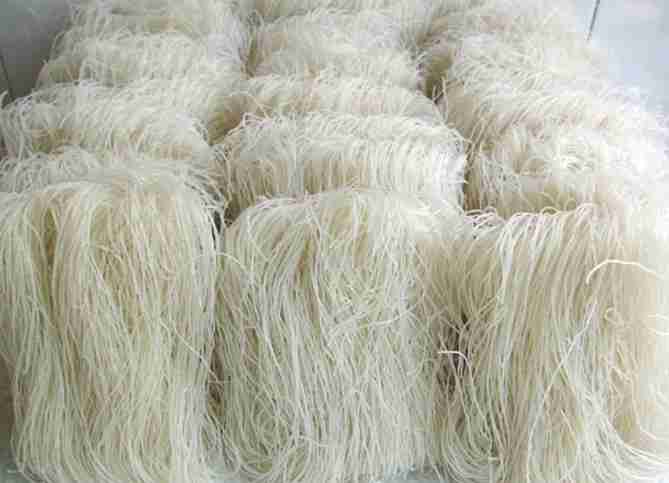
For this method add one to two cups of dry uncooked rice to the blender at a time. Adding in small amounts usually gives the blades enough room to grind the rice efficiently. Normally one cup of rice should give you one and a half cups of flour.
After adding the rice, cover the blender and turn it on to its highest setting. Keep in mind that if you’re going to make a lot of rice flour constantly, then you need to invest in a quality blender. That’s because the grains are hard on the blades.
Once the flour is fine ground pour it in an air-tight container or a resealable bag once all the air has been pushed out. If air happens to leak into the container, then the flour will spoil faster. Also, if you keep the flour too long it will start getting stale and musty. So, ensure you date the container before storing it so you can keep track of the storage time. You can either store the flour in the pantry or freezer. Storing in the latter will ensure it lasts longer.
Grinding using a coffee grinder
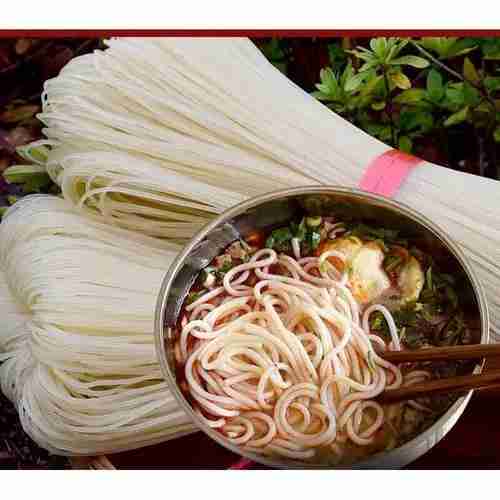
Unless you want your rice flour to taste like coffee, you need to start by cleaning out the grinder and removing any coffee. You can use a small spatula although a paintbrush is better for reaching the difficult corners. Ensure it is switched off while cleaning it. Once clean add 2-3 tablespoons of dry uncooked rice grains into the grinder at a time to avoid clogging. Turn on and grind until smooth. You might have to do it twice in the first round still produced coarse flour. When the flour is finely grounded, transfer it into an airtight container and place it in the pantry or fridge after dating the container.
Dry milling using a grain mill
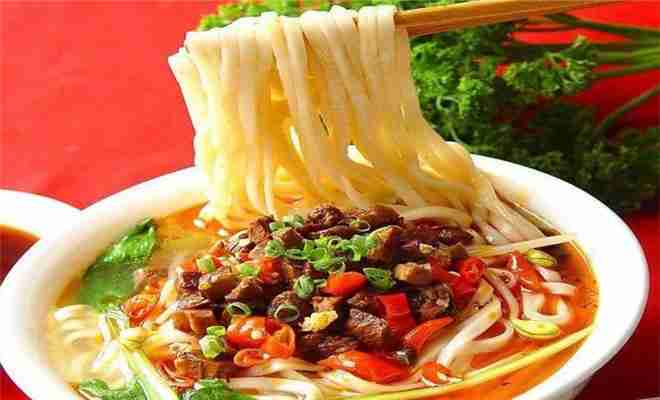
Start by turning on the grain mill to its highest setting, to ensure the resulting flour will be finely ground. While it is on, slowly pours the uncooked dry rice grains into the hopper at the top of the mill. It will automatically grind the grains and drop the resulting flour in the canister attached to it. Turn off the mill once all the rice grains have been fully ground. Detach the canister and pour the flour into an airtight container. Date the container and store it in the pantry or freezer for up to 1 year.
For the wet mill, first, soak the rice grains overnight and grounding them with a stone mill. The flour is then sifted and placed in an airtight container and placed in the freezer. This type of flour normally tends to form soft lumps that you can easily break with your hands.
What To Do with Chinese Rice Flour?
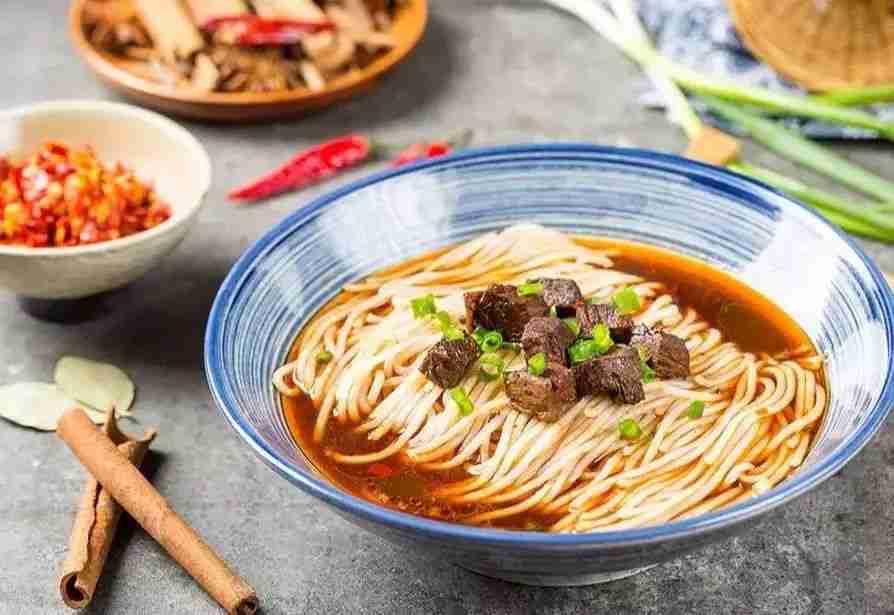
Like we mentioned earlier there is a lot you can do with rice flour including making dumpling wrappers and rice noodles. You can also use it for coating in place of wheat flour. It’s also used in baking, especially gluten-free pastries. We want to share with you a recipe for a Chinese traditional pastry called rice flour huat kueh. It’s a lightly sweet tasting pastry, slightly chewy and soft when warm and dries up when frozen. It’s one of the easiest recipes you can make. The following are the ingredients you’ll need:
- Red food coloring
- 150 grams of rice flour
- 120 ml coconut milk
- 80 grams of icing sugar
- 1 teaspoon baking powder
- 1/8 teaspoon salt
Start by boiling water in the steamer. Line the cups with a paper liner (alternatively if you’re using small teacups then lightly oil them) Next mix together baking powder, salt, icing sugar, and rice flour. Then add coconut milk and stir until the batter is thick. For coloring, add a few drops of red food coloring depending on how deep you want the color. Once the batter is ready, use a spoon to scoop the batter. Fill the cups 3/4 way and steam over high heat for 15 minutes. After that, check the cake. The cake tester should come out clean. If they’ve been cooked through, take a cool down in the cup for 5 minutes and then transfer to a cooling rack to let them cool down completely. They’re now ready to be consumed.
are rice noodles healthy?
Rice noodles can be a healthy option as part of a balanced diet, but their nutritional value can vary depending on the specific type and how they are prepared. Here are some factors to consider:
Low in Fat: Rice noodles are typically low in fat, which can be beneficial for those watching their fat intake or trying to maintain a healthy weight.
Gluten-Free: Rice noodles are naturally gluten-free, making them a suitable choice for individuals with gluten intolerance or celiac disease.
Carbohydrates: Rice noodles are primarily made of carbohydrates, providing energy for the body. However, they are lower in fiber compared to whole grain options, which means they may not have the same satiety benefits or contribute to digestive health as much.
Limited Nutrients: Rice noodles are not a significant source of essential nutrients like vitamins or minerals. Their nutritional profile is relatively neutral, providing mainly energy without significant amounts of other nutrients.
Sodium Content: Some pre-packaged or restaurant-prepared rice noodles may contain added salt or be served in sauces or broths with high sodium content. This can be a concern for individuals with high blood pressure or those aiming to reduce their sodium intake.
To make rice noodle dishes healthier, consider incorporating a variety of colorful vegetables, lean proteins, and healthy fats to enhance the nutritional value. Additionally, opting for homemade or less processed versions of rice noodles can help control added ingredients like sodium and preservatives.
are rice noodles gluten free?
Yes, rice noodles are typically gluten-free. Unlike wheat noodles or pasta, which contain gluten, rice noodles are made from rice flour or rice starch, making them suitable for individuals with gluten intolerance or celiac disease. However, it’s important to check the packaging or labels of rice noodle products to ensure they are specifically labeled as gluten-free, as some brands or varieties may have added ingredients that contain gluten or may be processed in facilities that also handle gluten-containing products.
are rice noodles low carb?
Rice noodles are generally not considered low in carbohydrates. They are made from rice flour or rice starch, which contains a significant amount of carbohydrates. The exact carbohydrate content can vary depending on the brand and specific type of rice noodles.
While rice noodles do not contain gluten, which is beneficial for individuals with gluten sensitivities or celiac disease, they are still relatively high in carbs compared to other low-carb alternatives like zucchini noodles (zoodles) or shirataki noodles.
If you’re following a low-carb diet, it’s recommended to opt for alternative noodle options such as spiralized vegetables or shirataki noodles made from konjac flour, which are very low in carbs. These alternatives can provide a similar texture to rice noodles without the high carbohydrate content.
are rice noodles low fiber?
Yes, rice noodles are generally low in fiber. They are primarily made from refined rice flour or rice starch, which undergoes a process that removes much of the dietary fiber present in whole rice grains. As a result, rice noodles contain minimal amounts of fiber compared to other types of noodles or whole grain alternatives.
Fiber is an important component of a healthy diet as it aids in digestion, helps regulate blood sugar levels, promotes satiety, and supports overall gut health. If you’re looking to increase your fiber intake, you may want to consider incorporating other foods such as whole grains, legumes, fruits, vegetables, and whole wheat noodles into your meals.
are rice noodles vegan?
Yes, rice noodles are typically vegan. They are made from rice flour or rice starch, which are plant-based ingredients and do not contain any animal products. Additionally, rice noodles are generally free from eggs or any other animal-derived ingredients.
However, as with any food product, it’s always a good idea to check the specific brand and packaging to ensure that there are no additional ingredients or additives that may not be vegan-friendly. Some flavored or pre-packaged rice noodle products might include non-vegan ingredients such as meat extracts, fish sauce, or shrimp paste, so it’s important to read the label carefully if you are following a vegan diet.
are rice noodles healthier than pasta?
The healthiness of rice noodles versus pasta depends on various factors and dietary considerations. Here’s a comparison to help you understand their differences:
Nutritional Composition: Rice noodles and pasta can differ in their nutrient profiles. Rice noodles are typically gluten-free and may contain fewer calories and less fat than traditional wheat-based pasta. However, they tend to be lower in protein and fiber. Whole wheat pasta, on the other hand, contains more fiber and protein while providing a range of essential nutrients.
Carbohydrate Content: Both rice noodles and pasta are high in carbohydrates, as they are primarily made from starch. However, the type of carbohydrate can vary. Rice noodles are often considered to be high on the glycemic index, meaning they can cause a quicker rise in blood sugar levels compared to whole wheat pasta, which has a lower glycemic index due to its higher fiber content.
Dietary Considerations: For individuals with gluten sensitivities or celiac disease, rice noodles offer a gluten-free alternative to wheat-based pasta. Rice noodles can be a suitable option for those following a gluten-free diet.
Portion Size and Preparation: The healthiness of rice noodles or pasta also depends on portion sizes and preparation methods. Overeating either can lead to excess calorie intake. Opting for smaller portions and incorporating nutrient-dense ingredients like vegetables, lean proteins, and healthy fats can enhance the nutritional value of the dish.
Ultimately, the healthiness of rice noodles versus pasta depends on your specific dietary needs, preferences, and overall balanced meal choices. It’s important to consider your individual goals and nutritional requirements when choosing between the two.
why are rice noodles chewy?
Rice noodles have a characteristic chewy texture due to the unique properties of rice flour and the cooking process involved. Here are a few reasons why rice noodles can be chewy:
Rice Flour Composition: Rice flour, the main ingredient in rice noodles, is made by grinding rice grains into a fine powder. Rice flour contains a type of starch called amylopectin, which gives it its characteristic chewy texture when cooked. The amylopectin in rice flour has a tendency to gelatinize and form a sticky texture when heated, resulting in the chewiness of rice noodles.
Cooking Method: The cooking method used for rice noodles can also impact their texture. Rice noodles are typically soaked in hot water or briefly boiled until they soften. However, they are generally not cooked for an extended period like pasta. The shorter cooking time helps preserve the chewiness of the noodles.
Moisture Content: Rice noodles have a lower moisture content compared to wheat-based pasta. The lower moisture content contributes to their chewy texture when cooked. If rice noodles are overcooked or exposed to excessive moisture, they can become mushy instead of chewy.
It’s worth noting that the specific type and brand of rice noodles can also affect their texture. Some varieties of rice noodles may be thicker or thinner, which can influence the level of chewiness. Additionally, personal preferences for texture may vary, and some individuals may prefer their rice noodles softer or less chewy. Adjusting cooking times or techniques can help achieve the desired texture for your rice noodles.
why soak rice noodles?
Soaking rice noodles serves several purposes and is an important step in the preparation process. Here are a few reasons why soaking rice noodles is typically recommended:
Softening the Noodles: Rice noodles are dry and brittle when they are purchased. Soaking them in water rehydrates and softens them, making them pliable and ready for cooking. This helps ensure that the noodles have a pleasant texture when they are added to dishes.
Promoting Even Cooking: Soaking rice noodles helps promote even cooking throughout the noodles. It allows the noodles to absorb water and become uniformly hydrated, ensuring that they cook evenly and do not have any hard or undercooked sections.
Preventing Sticking: Soaking rice noodles helps prevent them from sticking together during the cooking process. By separating the individual strands, the noodles are less likely to clump together and form a sticky mass.
Reducing Cooking Time: Soaking rice noodles can help reduce the overall cooking time. When the noodles have been pre-soaked and softened, they require less time in the boiling water or stir-frying process to reach the desired texture. This can be particularly helpful when preparing quick and easy meals.
The length of time required for soaking rice noodles can vary depending on the thickness of the noodles. Thinner noodles might only need a brief soak in hot water, while thicker noodles might require a longer soaking period. It’s best to follow the instructions provided on the package or consult a recipe for specific soaking times and methods.
how are rice noodles made?
Rice noodles are made from rice flour or rice starch. The process of making rice noodles involves several steps, which can vary slightly depending on the specific recipe or region. Here is a general overview of how rice noodles are made:
Rice Flour Preparation: Rice flour is typically made by grinding rice grains into a fine powder. The rice used can vary, including varieties such as jasmine rice, glutinous rice, or long-grain rice. The rice is first washed and soaked to remove any impurities or excess starch. It is then drained and dried before being ground into a flour consistency.
Mixing the Rice Flour: The rice flour is mixed with water to form a smooth batter or dough. The ratio of rice flour to water can vary depending on the desired texture and thickness of the noodles.
Steaming or Boiling: The batter or dough is then cooked by either steaming or boiling. For steaming, the batter is spread thinly on a flat surface or in a steaming tray and steamed until it solidifies. Alternatively, the batter can be poured into a boiling water mixture and cooked until it forms a cohesive mass.
Cooling and Cutting: After cooking, the rice noodle sheet is cooled to room temperature or chilled to make it easier to handle. The cooled sheet is then cut into the desired noodle shapes and sizes. The noodles can be thin like vermicelli or wider like flat rice noodles.
Drying or Packaging: Depending on the production process, the freshly cut rice noodles may be dried under controlled conditions to reduce moisture content and extend shelf life. Alternatively, they may be packaged immediately for sale or used in fresh rice noodle products.
It’s important to note that the specific techniques and ingredients can vary based on regional variations and traditional methods. Different cultures have their own variations of rice noodles, resulting in a diverse range of shapes, sizes, and textures.
how to cook rice noodles?
Cooking rice noodles is a relatively simple process. Here’s a general guide on how to cook rice noodles:
Soak the Rice Noodles: Place the desired amount of rice noodles in a large bowl and cover them with hot water. The water should be hot, but not boiling. The soaking time can vary depending on the thickness of the noodles, so follow the instructions on the package. Typically, rice noodles require soaking for about 5 to 10 minutes until they become soft and pliable.
Drain the Noodles: Once the noodles are soft, drain them in a colander or sieve to remove excess water. Rinse them briefly with cold water to stop the cooking process and prevent sticking. Gently separate the noodles with your fingers or a fork to ensure they don’t clump together.
Cooking Methods:
Stir-Frying: Heat a wok or large skillet over medium-high heat. Add a small amount of oil and any desired vegetables, proteins, or seasonings. Stir-fry them briefly until they start to cook. Add the soaked and drained rice noodles to the pan and continue stir-frying for a few more minutes until the noodles are heated through and well-coated with the flavors.
Boiling: Bring a pot of water to a boil. Add the soaked and drained rice noodles to the boiling water and cook for a few minutes until they reach the desired texture. Be careful not to overcook them, as rice noodles can become mushy quickly. Test the noodles for doneness by tasting them or checking the package instructions.
Season and Serve: Once the rice noodles are cooked, you can season them with your choice of sauces, herbs, spices, or toppings. Common additions include soy sauce, oyster sauce, fish sauce, lime juice, cilantro, green onions, or sesame oil. Toss the noodles gently to distribute the flavors evenly.
It’s important to note that cooking times and methods can vary based on the thickness and specific type of rice noodles you’re using. Always refer to the instructions provided on the package for the most accurate cooking guidelines.
how to cook rice noodles without sticking?
To prevent rice noodles from sticking together during the cooking process, here are a few tips:
Properly Soak the Noodles: Ensure that you soak the rice noodles in hot water according to the package instructions. This step helps soften the noodles and separate them, reducing the chances of sticking.
Use Sufficient Water: When boiling the soaked rice noodles, use a large pot with ample water. Having enough water helps create space for the noodles to move freely and prevents them from clumping together.
Add Oil to the Water: Before adding the rice noodles to the boiling water, you can add a tablespoon of cooking oil (such as vegetable or sesame oil) to the water. The oil creates a thin coating on the noodles, minimizing the chances of sticking.
Stir the Noodles: Once the rice noodles are added to the boiling water, stir them gently using a fork or chopsticks. This prevents them from sticking together and helps separate the strands. Stir occasionally during the cooking process.
Cook Al Dente: Avoid overcooking the rice noodles, as they can become mushy and more prone to sticking. Cook them until they are just tender but still have a slight bite to them. Keep a close eye on the noodles and test for doneness by tasting them or following the package instructions.
Rinse with Cold Water: After cooking, drain the rice noodles and rinse them briefly with cold water. This halts the cooking process and removes any excess starch that can contribute to sticking. Give the noodles a gentle toss or separate them with your fingers while rinsing.
Cook in Small Batches: If you’re cooking a large amount of rice noodles, it’s best to cook them in smaller batches rather than overcrowding the pot. Cooking smaller quantities allows for better water circulation and reduces the chances of sticking.
By following these tips, you can minimize the risk of rice noodles sticking together and enjoy separate, well-cooked strands.
how to cook rice noodles for stir fry?
To cook rice noodles for a stir-fry, follow these steps:
Soak the Rice Noodles: Place the desired amount of rice noodles in a large bowl and cover them with hot water. Let them soak for about 5 to 10 minutes or until they become soft and pliable. The exact soaking time may vary, so check the package instructions.
Prepare the Stir-Fry Ingredients: While the rice noodles are soaking, prepare your stir-fry ingredients. This typically includes vegetables, protein (such as tofu, chicken, shrimp, or beef), and any desired seasonings or sauces.
Drain and Rinse the Noodles: Once the noodles are soft, drain them in a colander or sieve. Rinse them briefly with cold water to stop the cooking process and remove any excess starch. Gently separate the noodles with your fingers or a fork to prevent them from clumping together.
Stir-Fry the Ingredients: Heat a wok or large skillet over medium-high heat. Add a small amount of oil (such as vegetable or sesame oil) and allow it to heat. Add your vegetables and protein, stir-frying them until they begin to cook and become tender. You can add garlic, ginger, or other seasonings at this point for flavor.
Add the Noodles: Push the stir-fry ingredients to one side of the pan and add the drained rice noodles to the empty space. Allow the noodles to heat up for a minute or two before mixing them with the other ingredients. Use tongs or a spatula to gently toss and combine everything together.
Sauce and Season: Pour your desired sauce or seasonings over the noodles and stir-fry ingredients. This could include soy sauce, oyster sauce, hoisin sauce, or a homemade stir-fry sauce. Toss everything together to coat the noodles and evenly distribute the flavors.
Cook Until Heated Through: Continue stir-frying the noodles and ingredients until everything is heated through and well-combined. Be careful not to overcook the noodles, as they can become mushy. Taste a noodle to check for doneness and adjust the seasoning if needed.
Serve: Once the noodles are cooked to your liking, remove the stir-fry from the heat. Transfer it to a serving dish and garnish with fresh herbs, sesame seeds, or chopped green onions, if desired. Serve hot and enjoy!
Remember, cooking times and ingredient combinations can vary depending on your specific stir-fry recipe, so feel free to experiment and customize the flavors to your liking.
rice noodles history
There are multiple theories regarding the origin of rice noodles, and one of them suggests that rice noodles were created by the northern Chinese people who migrated to the south during the turbulent period of the Five Barbarians’ incursions. Another theory relates the origin of rice noodles to the time when Emperor Qin Shi Huang attacked Guilin. As the northern soldiers were not accustomed to eating southern-style rice, people ground rice into flour and shaped it into noodle form to alleviate the soldiers’ homesickness. During the Qing Dynasty and the Republic of China, Guilin rice noodles reached their peak. Notable establishments such as Xuan Rong Zhai, Hui Xian Zhai, and Yi Rong Zhai each had their own specialties, attracting numerous returning customers. Instead of competing against each other, these establishments encouraged one another and innovated in their own ways. This camaraderie among the three establishments is still celebrated today.
Guilin rice noodles later gave rise to variations such as cold toss rice noodles, sour and spicy rice noodles, three-delight rice noodles, and beef brisket rice noodles, injecting unlimited vitality into the rice noodle culture. The inclusiveness of Guilin rice noodles towards dishes like Liuzhou snail rice noodles and Guangdong rolled rice noodles further enriches its foundation. Guilin rice noodles provide endless topics for discussion, whether it’s the story of Li Zongren, who, upon becoming the interim president, sent a special plane to Guilin to bring back rice noodles to Nanjing to dispel rumors, or the taste of starting the day with a bowl of rice noodles accompanied by Three Flowers Liquor, which continues until noon. As the saying goes, “Even after becoming an emperor, one still desires to be a deity.” With rice noodles and Three Flowers Liquor, who wouldn’t want to be a deity? Rice noodle shops are scattered all over Guilin’s streets. Some vendors who initially came to Guilin to sell snacks from other regions later discovered the locals’ attachment to rice noodles and had no choice but to switch to selling rice noodles. Some people are unaware of the subtleties of brewing the soup base and mistakenly believe that the soup base is just soy sauce with monosodium glutamate, causing Guilin locals to spit out the noodles after taking a bite. In reality, becoming a true master of rice noodles is no easy task. Chinese cuisine involves countless techniques, and Guilin rice noodles incorporate almost all the techniques of Chinese cuisine, demonstrating exceptional skill. If Guilin rice noodles can be considered a culinary art classic, it is well-deserved. In the Guilin Rice Noodle Cultural Art Museum, you can find the following passage: “Guilin rice noodles are the pioneer of the fast food industry worldwide; Guilin rice noodles represent Chinese food culture; Guilin rice noodles are a culinary art classic; Guilin rice noodles are a testament to ethnic integration.”
who invented rice noodles?
The legend of rice noodles in China has various versions, and here are three popular ones:
Legend 1:
According to this legend, during the Qin Dynasty, Emperor Qin Shi Huang visited Guilin with his prime minister, Li Si, after the completion of the Ling Canal. The emperor had a fondness for using the whiskers and swim bladders of carp to accompany his drinks. When he saw the abundance of carp in the Li River, he was delighted and ordered the boatmen to catch them. However, it took many carp to make a single dish, and over the course of half a month, the emperor had thousands of carp killed. This angered the Carp King of the Li River, who vowed to overturn the emperor’s boat and devour him. The River God warned the Carp King that such actions would not befit an emperor, so they should find another solution. The Carp King came up with a clever idea and ground rice into a paste, creating fish whiskers (rice noodles) and fish bladders (sliced rice noodles). When the emperor tasted them, he was amazed, and from then on, rice noodles came into existence.
Legend 2:
Another legend states that rice noodles were invented by soldiers during the construction of the Ling Canal. It is said that Marco Polo, an Italian explorer, discovered rice noodles during his visit to Guilin and brought them back to Italy, where they were transformed into Italian pasta. However, these claims are just legends and cannot be verified.
Legend 3:
This legend tells the story of a young ferryman named Mu Ge in Dunmu Village, Yanshan District, Guilin. Mu Ge came from a poor family and took care of his elderly and sick mother. There were two villages along the Peach Blossom River that were constantly fighting over land and forests. Mu Ge was deeply saddened by this and tried to persuade them to stop, but his words fell on deaf ears. One evening, as Mu Ge was about to return home, he saw a fierce osprey swooping down and grabbing a carp. Acting swiftly, he threw a harpoon at the osprey, rescuing the carp. The carp turned out to be the daughter of the Dragon King, who, in gratitude, left a few carp whiskers and taught Mu Ge how to make rice noodles using them. Mu Ge cooked a bowl of rice noodles for his mother, and miraculously, her health improved. The aroma of the rice noodles spread far and wide, attracting people from neighboring areas who wanted to learn the art of making rice noodles. This event led to the merging of the two warring villages into a single village called “Dunlinli,” meaning “promoting harmony.” Rice noodles gradually spread throughout Guilin.
where did rice noodles originated?
According to the records in Qian Zhongshu’s “Guan Zhui Bian,” rice noodles, also known as rice vermicelli, originated in Jiujiang, Jiangxi province, and have a history of over 1800 years. This means that people from Jiangxi began slurping rice noodles more than 1800 years ago.
what does rice noodles symbolize in china?
- The understanding of rice noodles can vary across different regions and among different people. In some places, rice noodles are seen as a symbol of family happiness, unity, and friendship. Eating rice noodles throughout the seasons signifies a smooth and harmonious life for the whole family, just like the smooth and continuous flow of rice noodles.
- Rice noodles also carry symbolic meanings, representing the wish for parents to live a long life. The whiteness and thinness of rice noodles resemble the silver hair and fine strands of an elderly person. By gifting rice noodles during the Mid-Autumn Festival, it conveys the wish for parents to live a long and healthy life.
- Rice noodles are mostly flat and elongated in shape, symbolizing longevity and smooth sailing.
rice noodle in New Year
The tradition of eating noodles on the eve of the Chinese New Year is commonly observed in the Northeast region and Guangxi region. Although the northern region prefers wheat noodles (粉条) while Guangxi region favors rice noodles (米粉), the reasons for eating noodles are similar. It allows people to enjoy delicious food while symbolizing a smooth sailing year ahead.
Eating rice noodles during festivals and special occasions symbolizes auspiciousness and good health. Consuming rice noodles daily represents the wish for a long and prosperous life, just like the continuous flow of rice noodles.
For the Chinese New Year’s Eve dinner, stir-fried rice noodles imply an abundance of rice crops, a bountiful harvest, and a rise in fortune with each passing year. The similarity between rice noodles and white hair also signifies the desire for elderly individuals to enjoy an extended lifespan.
rice noodle in Chinese wedding
Sending rice noodles as a traditional blessing signifies “having a beautiful life and smooth sailing in all endeavors.” In some regions, rice noodles are sent as a blessing on occasions such as weddings, childbirth, or moving to a new home.
When the parents of the bride send rice noodles to the future son-in-law, it is a wish for a long and happy marriage.
In ancient cooking texts, such as the lost book “Shi Ci” from the Southern Song Dynasty, rice noodles were referred to as “can” (粲), which originally meant high-quality white rice. “Can” is also known as “luan ji,” which can be understood as a pile of rice noodles together.
During the Ming and Qing dynasties, rice noodles were also called “mi lang.” In Song Xu’s “Song Shi Yang Sheng Bu,” it is mentioned, “Mi lang, pronounced as ‘lan,’ thanks to overlapping mountains and clouds, called ‘mi xian’.” “Lang” is explained as rice that becomes soft and sticky.
The idea of being “piled together” or “sticking together” implies harmony and love.
Furthermore, the pure and bright white color of rice noodles represents the purity of love.
rice noodle in Chinese Birthday
On the birthdays of teenagers, parents often cook a bowl of noodles or rice noodles with two eggs. In places like Jinjiang and Quanzhou, it may be one chicken egg and one duck egg. People from Xiamen also add a few stalks of chives, while Pinghe people include sliced sausages with the noodles, rice noodles, chives, and sausages, all symbolizing longevity. Eggs represent peace, and the act of breaking the shell signifies growth. This practice serves as both a wish for the child to be free from disasters and obstacles and to grow up quickly, as well as a reminder for the family not to forget the child’s birthday.
rice noodle in Chinese medicine
Rice noodles are widely enjoyed, especially in places like Yunnan, where they have become a staple for many people. Not only are they delicious, but they also offer various nutritional benefits. When eating rice noodles, there are many ingredients that can be paired with them. For example, adding lotus root can help nourish the body. It’s important to be aware of some considerations when consuming rice noodles, especially when choosing them for infants and young children.
What can be eaten with rice noodles:
Rice noodles + lotus root: Helps regulate blood and Qi, clears heat, and generates body fluids.
Rice noodles + black sesame seeds: Nourishes the spleen and stomach, benefits the liver and kidneys.
Rice noodles + chestnuts: Tonifies the middle and replenishes Qi.
Nutritional value of rice noodles per 100g:
Energy: 348 kcal
Protein: 7.3g
Fat: 1g
Carbohydrates: 77.5g
Folic acid: 18.7mcg
Dietary fiber: 0.8g
Thiamine: 0.11mg
Riboflavin: 0.04mg
Niacin: 2.3mg
Vitamin E: 1.29mg
Calcium: 26mg
Phosphorus: 113mg
Potassium: 137mg
Sodium: 1.5mg
Magnesium: 49mg
Iron: 1.4mg
Zinc: 1.54mg
Selenium: 2.71mcg
Copper: 0.25mg
Manganese: 1.54mg.
rice noodle vs glass noodle
Rice noodles and glass noodles are two different types of noodles made from distinct ingredients, resulting in variations in texture, taste, and culinary uses.
Rice Noodles: Rice noodles, as the name suggests, are made from rice flour or rice starch. They are a staple in many Asian cuisines, such as Vietnamese, Thai, and Chinese cuisine. Rice noodles come in various shapes and sizes, including thin vermicelli, flat sheets, or wide ribbons. They have a soft and chewy texture when cooked and are known for their ability to absorb flavors from sauces and soups. Rice noodles are often used in dishes like Pad Thai, Pho, and stir-fries.
Glass Noodles: Glass noodles, also known as cellophane noodles or bean thread noodles, are typically made from mung bean starch or sometimes from other starches like potato or sweet potato starch. They are transparent and have a delicate, gelatinous texture when cooked. Glass noodles are commonly used in East and Southeast Asian cuisines, including Chinese, Korean, and Thai dishes. They are versatile and can be used in soups, stir-fries, salads, and spring rolls. Glass noodles are often rehydrated by soaking them in hot water before using in recipes.
In terms of taste, both rice noodles and glass noodles are fairly neutral, allowing them to absorb the flavors of accompanying ingredients and sauces. The choice between the two depends on personal preference and the specific dish being prepared.
Overall, while rice noodles and glass noodles share similarities as popular Asian noodle varieties, their distinct textures and origins make them suitable for different culinary applications.
rice noodle vs egg noodle
Rice noodles and egg noodles are two distinct types of noodles with differences in their ingredients, texture, and culinary uses.
Rice Noodles: Rice noodles, as the name implies, are made from rice flour or rice starch. They are commonly used in Asian cuisines, particularly in dishes like stir-fries, soups, and spring rolls. Rice noodles come in various thicknesses, from thin vermicelli to wider flat noodles. They have a soft and chewy texture when cooked and are known for their ability to absorb flavors from sauces and broths. Rice noodles are gluten-free, making them suitable for individuals with gluten sensitivities or dietary restrictions.
Egg Noodles: Egg noodles are made from wheat flour and eggs, giving them a yellow color and a richer flavor compared to rice noodles. They have a slightly chewy texture and a firmer bite. Egg noodles are commonly used in Western cuisines, such as Italian pasta dishes, as well as in Asian dishes like stir-fries and soups. They come in various shapes and sizes, including thin spaghetti-like strands, broader ribbons, or curly varieties like egg noodles used in chicken noodle soup.
The choice between rice noodles and egg noodles depends on personal preference and the specific dish being prepared. Rice noodles are lighter and have a more delicate texture, while egg noodles have a heartier and richer taste. It’s worth noting that egg noodles contain gluten, so they may not be suitable for individuals with gluten allergies or sensitivities.
In summary, rice noodles and egg noodles differ in their ingredients, texture, and culinary uses. Rice noodles are gluten-free and have a soft, chewy texture, while egg noodles are made with wheat flour and eggs, offering a firmer bite and richer flavor. Both noodles are versatile and can be enjoyed in various dishes based on individual preferences and cultural traditions.
rice noodle vs vermicelli
The term “vermicelli” is often used interchangeably with “rice noodles,” but it can refer to different types of noodles depending on the context and cuisine. However, in many cases, vermicelli does refer to a specific type of rice noodle. Let’s explore the comparison between rice noodles and vermicelli:
Rice Noodles: Rice noodles are thin, flat noodles made from rice flour or rice starch. They are commonly used in Asian cuisines, including Chinese, Thai, Vietnamese, and Malaysian dishes. Rice noodles come in different thicknesses, ranging from thin to wide. They have a soft, smooth texture when cooked and are known for their ability to absorb flavors from sauces and soups.
Vermicelli: In some culinary contexts, vermicelli refers specifically to thin rice noodles. These noodles are often referred to as rice vermicelli or rice stick noodles. They are similar to other rice noodles but are specifically thin in diameter, resembling strands of thread. Vermicelli is commonly used in dishes like Vietnamese pho, Thai pad Thai, and Singaporean laksa. It is also a popular choice for cold noodle salads.
In summary, rice noodles are a broader category that encompasses various types of noodles made from rice flour or rice starch. Vermicelli, on the other hand, often refers to thin rice noodles or rice stick noodles. Therefore, while all vermicelli can be considered rice noodles, not all rice noodles are necessarily vermicelli. The choice between rice noodles and vermicelli depends on the specific dish and personal preference for the thickness of the noodles.
rice noodle vs yellow noodle
Rice noodles and yellow noodles are two distinct types of noodles commonly used in different cuisines. Here’s a comparison between rice noodles and yellow noodles:
Rice Noodles: Rice noodles are made from rice flour or rice starch and are a staple in various Asian cuisines, including Chinese, Thai, Vietnamese, and Malaysian. They have a translucent appearance when cooked and a soft, smooth texture. Rice noodles come in different widths, from thin to wide, and are often used in stir-fries, soups, and spring rolls. They have a mild taste and tend to absorb the flavors of the accompanying sauces and ingredients.
Yellow Noodles: Yellow noodles, also known as wheat noodles or egg noodles, are made from wheat flour and often contain eggs, giving them a yellow color. They are commonly used in Chinese, Indonesian, and Malaysian cuisines. Yellow noodles have a chewy texture and a slightly rich and savory flavor. They are versatile and can be stir-fried, boiled, or used in soups and noodle dishes. Yellow noodles are firmer compared to rice noodles and hold their shape well during cooking.
In summary, the main differences between rice noodles and yellow noodles lie in their composition and texture. Rice noodles are made from rice flour and have a softer, smoother texture, while yellow noodles are made from wheat flour (often with eggs) and have a chewier texture. The choice between rice noodles and yellow noodles depends on personal preference and the specific dish being prepared.
rice noodle vs pasta
Rice noodles and pasta are two different types of noodles that are commonly used in various cuisines around the world. Here are some key differences between rice noodles and pasta:
Ingredients: Rice noodles are made from rice flour or rice starch, whereas pasta is typically made from wheat flour, eggs, and water. The difference in ingredients gives each type of noodle a distinct taste and texture.
Texture: Rice noodles tend to be softer and more delicate in texture compared to pasta. They have a smooth, slippery surface and are often used in soups, stir-fries, or in dishes like pad Thai. Pasta, on the other hand, can have a range of textures depending on the type. Some pasta is smooth and tender when cooked, while others have a more chewy or al dente texture.
Cooking Time: Rice noodles usually have a shorter cooking time compared to pasta. Depending on the thickness, rice noodles may only require a few minutes of soaking in hot water, while pasta typically needs to be boiled for several minutes until al dente.
Culinary Uses: Rice noodles are commonly used in Asian cuisines such as Thai, Vietnamese, and Chinese dishes. They are often used in stir-fries, soups, spring rolls, and cold salads. Pasta, on the other hand, is popular in Italian cuisine and is used in a wide range of dishes like spaghetti, lasagna, macaroni and cheese, and more.
Gluten-Free Option: Rice noodles are naturally gluten-free since they are made from rice flour, making them a suitable option for individuals with gluten intolerance or celiac disease. In contrast, most types of pasta are made from wheat flour and contain gluten, although gluten-free pasta options are available made from alternative flours like rice, corn, or quinoa.
Ultimately, the choice between rice noodles and pasta depends on personal preference and the cuisine you’re preparing. Both types of noodles offer unique qualities that can enhance different dishes.
rice noodle vs rice
Rice noodles and rice are both made from rice but have distinct differences in their form and culinary uses. Here are some key differences between rice noodles and rice:
Form: Rice noodles are thin, elongated strands made from rice flour or rice starch, which are typically dried or fresh. They can vary in thickness and width, depending on the specific type of rice noodle. On the other hand, rice is a grain that comes in the form of individual grains that are cooked and swollen.
Texture: Rice noodles have a soft, chewy texture when cooked properly. They can range from thin and delicate to wider and more substantial noodles, depending on the variety. Rice, when cooked, has a fluffy and tender texture, with each grain separate and distinct.
Culinary Uses: Rice noodles are commonly used in various Asian dishes, particularly in Thai, Vietnamese, and Chinese cuisine. They are often used in stir-fries, soups, salads, and spring rolls. Rice, on the other hand, is a staple food in many cultures around the world and serves as a primary component of meals. It can be enjoyed as a side dish, combined with various proteins, vegetables, or sauces.
Preparation: Rice noodles typically require soaking in hot water or boiling briefly before using them in a recipe. They absorb liquid quickly and become tender. Rice, on the other hand, needs to be rinsed and cooked in water or broth until it reaches the desired consistency. The cooking time for rice is longer compared to rice noodles.
Nutritional Profile: Both rice noodles and rice provide carbohydrates, but their nutritional content can differ. Rice noodles are generally lower in calories and fat compared to rice. However, the nutritional content can vary depending on the specific brand, type, and cooking method. Rice, especially brown rice, is a good source of fiber and various essential nutrients such as magnesium and B vitamins.
When deciding between rice noodles and rice, consider the specific dish you want to prepare and the desired texture. Rice noodles are ideal for Asian-inspired recipes or dishes that require a noodle-like component. Rice, on the other hand, is versatile and can be paired with a wide range of ingredients and flavors to create diverse cuisines from around the world.
Conclusion
When it comes to white and brown rice flour, they each have their benefits. White rice flour is cheaper, lasts longer, and the best option for baking light pastries. Brown rice flour on the other hand is best for baking denser pastries and adds a nutty touch. It’s also considered more nutritious. Overall, rice flour is useful especially if you’re looking for gluten-free options.